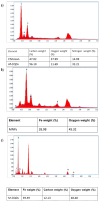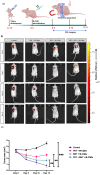Dual Functional Magnetic Nanoparticles Conjugated with Carbon Quantum Dots for Hyperthermia and Photodynamic Therapy for Cancer
- PMID: 38961886
- PMCID: PMC11217784
- DOI: 10.7150/ntno.91871
Dual Functional Magnetic Nanoparticles Conjugated with Carbon Quantum Dots for Hyperthermia and Photodynamic Therapy for Cancer
Abstract
The global incidence of cancer continues to rise, posing a significant public health concern. Although numerous cancer therapies exist, each has limitations and complications. The present study explores alternative cancer treatment approaches, combining hyperthermia and photodynamic therapy (PDT). Magnetic nanoparticles (MNPs) and amine-functionalized carbon quantum dots (A-CQDs) were synthesized separately and then covalently conjugated to form a single nanosystem for combinational therapy (M-CQDs). The successful conjugation was confirmed using zeta potential, Fourier transform infrared spectroscopy (FT-IR), and UV-visible spectroscopy. Morphological examination in transmission electron microscopy (TEM) further verified the conjugation of CQDs with MNPs. Energy dispersive X-ray spectroscopy (EDX) revealed that M-CQDs contain approximately 12 weight percentages of carbon. Hyperthermia studies showed that both MNP and M-CQDs maintain a constant therapeutic temperature at lower frequencies (260.84 kHz) with high specific absorption rates (SAR) of 118.11 and 95.04 W/g, respectively. In vitro studies demonstrated that MNPs, A-CQDs, and M-CQDs are non-toxic, and combinational therapy (PDT + hyperthermia) resulted in significantly lower cell viability (~4%) compared to individual therapies. Similar results were obtained with Hoechst and propidium iodide (PI) staining assays. Hence, the combination therapy of PDT and hyperthermia shows promise as a potential alternative to conventional therapies, and it could be further explored in combination with existing conventional treatments.
Keywords: cancer; hyperthermia; magnetic nanoparticles; nanoparticles; photodynamic therapy; quantum dots.
© The author(s).
Conflict of interest statement
Competing Interests: The authors have declared that no competing interest exists.
Figures










Similar articles
-
Manganese-doped green tea-derived carbon quantum dots as a targeted dual imaging and photodynamic therapy platform.J Biomed Mater Res B Appl Biomater. 2020 May;108(4):1616-1625. doi: 10.1002/jbm.b.34508. Epub 2019 Oct 23. J Biomed Mater Res B Appl Biomater. 2020. PMID: 31643134
-
A pseudohomogeneous nanocarrier based on carbon quantum dots decorated with arginine as an efficient gene delivery vehicle.Sci Rep. 2021 Jul 2;11(1):13790. doi: 10.1038/s41598-021-93153-4. Sci Rep. 2021. PMID: 34215792 Free PMC article.
-
Gadolinium-doped carbon quantum dots loaded magnetite nanoparticles as a bimodal nanoprobe for both fluorescence and magnetic resonance imaging.Magn Reson Imaging. 2020 May;68:113-120. doi: 10.1016/j.mri.2020.02.003. Epub 2020 Feb 4. Magn Reson Imaging. 2020. PMID: 32032662
-
Comprehensive understanding of magnetic hyperthermia for improving antitumor therapeutic efficacy.Theranostics. 2020 Feb 19;10(8):3793-3815. doi: 10.7150/thno.40805. eCollection 2020. Theranostics. 2020. PMID: 32206123 Free PMC article. Review.
-
Graphene quantum dots (GQDs)-based nanomaterials for improving photodynamic therapy in cancer treatment.Eur J Med Chem. 2019 Nov 15;182:111620. doi: 10.1016/j.ejmech.2019.111620. Epub 2019 Aug 12. Eur J Med Chem. 2019. PMID: 31470307 Review.
References
-
- Cancer Statistics. https://www.cancerresearchuk.org/health-professional/cancer-statistics/w....
-
- Hodgkinson N, Kruger CA, Abrahamse H. Targeted photodynamic therapy as potential treatment modality for the eradication of colon cancer and colon cancer stem cells. Tumor Biology. 2017;39(10):1010428317734691. - PubMed
-
- Kruger CA, Abrahamse H. Targeted photodynamic therapy as potential treatment modality for the eradication of colon cancer. Multidisciplinary Approach for Colorectal Cancer. 2019. 10. - PubMed
-
- Inoue K. 5-Aminolevulinic acid-mediated photodynamic therapy for bladder cancer. International Journal of Urology. 2017;24(2):97–101. - PubMed
Publication types
MeSH terms
Substances
LinkOut - more resources
Full Text Sources
Medical
Research Materials
Miscellaneous

